You are currently browsing the dc comics category
Tim noted
“My first real introduction to alternate universes was reading the classic ‘To Kill A Legend’ in a collection I had as a lad. The idea of Batman going to another universe with the chance to save the lives of his parents BLEW MY LITTLE BOY MIND.”
The comic that story originally appeared in was Detective Comics #500, released in late 1980/early 1981 when I was about 11 years old. Here’s the great jam cover that wrapped around this extra-sized funnybook:
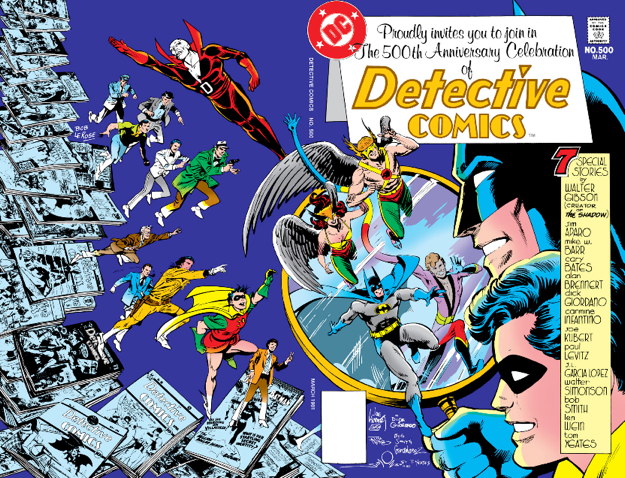
Very early on here on this site, I did a series of posts about anniversary issues, including an entry on this very issue giving an overview of all the contents.
In “To Kill A Legend” by Alan Brennert and Dick Giordano, the Phantom Stranger shows up to lay all this on the Caped Crusader:
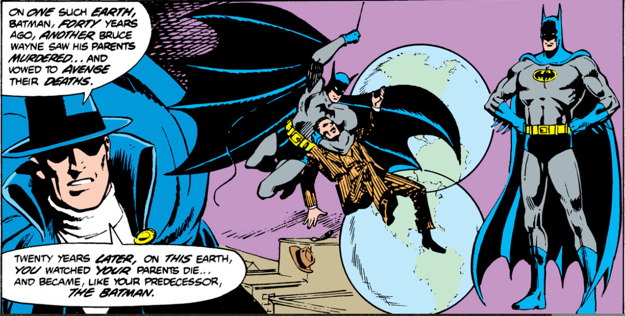

He’s obviously referring to the Earth-2 Batman as the Bruce Wayne whose parents were murdered 40 years ago (at then-press time), pictured there with an image evoking Batman’s first appearance on the cover of Detective Comics #27 back in 1939. The Bruce Wayne of “twenty years later” is Earth-1 Batman, the star of this particular show. (As an interesting side-note, assuming Bruce was somewhere between 5 to 10 years old at the time of the Waynes’ murders, that would put Earth-2 Batman at about 45-50 years old, and Earth-1 Bats at 25-30.)
The interesting implication of this story is not only that there is a new, apparently unnumbered parallel Earth in the DC Universe that may or may not have a Batman (not spoiling the story, you should read it!), but that there is a 20-year-cycle to these events duplicating in alternate universes. Going by that, we should’ve had another couple o’Batmans since then…and in a way, maybe we have, what with all the Crises and Rebirtheries, if perhaps not on a strict 20-year timeline.
It is a very good story, and one of the rare multiversal excursions in the DC Universe that doesn’t involve travel to one of the recognized Earths in the company’s established cosmology. To my knowledge this is the one and only trip to this particular Earth. There’s another parallel Earth that I think was only visisted once, in Justice League of America #38 where they go to…Earth-A? I haven’t read that yet, but I suspect I’ll be reporting on it here very soon.
Overall, this comic is excellent, so, Tim, and everyone else reading this, if you get a chance, give it a gander. I hope DC eventually releases a nice hardcover edition…there’s too much good material in this book as a whole for it to languish in back issue bins or be partially reprinted across trade paperbacks. But then, there are a lot of DC Comics of the past I wish they’d do that to.
I’m trying to put together this whole thing re: DC’s multiverse and it’s requiring me digging up scans left and right and frankly, I’m not the young, energetic blogger I used to be, staying up well past the witching hour with the hum of a scanner my only company. I’m still working on it, but in the meantime, let’s get back to your comments and questions and such:
Matthew Murray points out, in regards to the semi-fake out of Action #484 and the marriage of Earth-2 Lois and Supes
“The other tip off for that Action Comics cover is that it features the Daily Star newspaper.”
That’s fair enough, and it’s a fairly prominent background detail featured in the corner of the cover there. But — and this is a big but, I cannot lie about liking those — your average person not mired in DC’s parallel-Earth shenanigans isn’t going to recognize that as meaning anything. They might think, if they even notice it, “shouldn’t it be Daily Planet?” and if they think that represents any kind of in-story problem, there’s no natural way for them to expect the resolution to be “Superman from another universe, y’all.”
So my judgement remains “dick move,” at least as it stands in regards to the general public. And just slightly less of a dick move to folks more familiar with the milieu and observant enough to catch that detail. Plus, I don’t think DC itself ever emphasized that this was going to be not regular Superman taking a bride. Anyway, take that, 44-year-old Superman comic!
• • •
Hal Shipman
sails in with
“The parallel universes were never confusing to me and my friends – they were explained in one, maybe two panels. I never got the references in COIE stories about them being a problem.”
Yes, exactly…it was solving a problem that, at least internally, in comic book fandom, didn’t really exist. It didn’t take much to explain, like in this panel from Justice League of America #219 (1983) by Gerry Conway, Roy Thomas, Chuck Patton, and Romeo Tanghal:
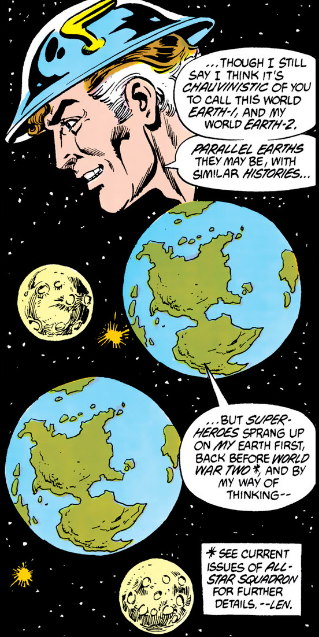
…and it was just off to the races. But I think it was a problem of public perception and confusion, as per that Action #484, that egged along a desire to streamline and get rid of potentially confusing elements such as “two Wonder Women” and the like. (Oh, and that specific letter published in New Teen Titans that inspired Marv Wolfman, but that’s a whole ‘nother thing.)
Or as you say:
“The ONE thing I kind of liked about the consolidated world was that it did make it easier to team up or make groups like the Giffen JL. But the constant retelling of pre-Crisis stories (especially in the Superman titles) to basically reintroduce elements was tiring.”
It did spare DC having to jump through hoops (or, you know, run a panel like the one above) in order to have the original Captain Marvel on a team with Guy Gardner without having to explain that he has to commute from Earth-S via the Rock of Eternity so he can help the Justice League fight the Gray Man. (No, not that Gray Man.)
The problem DC ran into with this sudden overhauling of their multiverse into one universe is that the readership from one era carried over into a new era. It wasn’t like the gap between the Golden Age and the Silver Age, where DC could introduce a new version of Hawkman as a space cop, and a new version of Green Lantern as…er, a space cop, and there was enough readership turnover in the meantime that they didn’t have a bunch of fans writing in demanding this new Hawkman and GL be reconciled with the previous versions of the characters. I mean, I’m sure some did, but a lot of those eight year old kids who rode out the end of the initial Golden Age superhero era probably didn’t come back at 16, pick up that issue of Showcase and suddenly go on a tear on 1940s Twitter with #notmyflash.
Or maybe they did. I don’t know, I wasn’t there, but I suspect that publishing gap gave DC enough of a clean break that they could essentially start over again with a minimum of reader confusion. The Crisis on Infinite Earths rejiggering had no such gap, and the folks reading before were told “forget everything you knew” and were along for the ride as DC tried to figure out in real time how this new fictional set-up was going to work.
The original plan of just restarting everything from scratch at the conclusion of Crisis might have been sufficient enough of a firebreak between What Came Before and What We’ve Got Now (well, Then-Now, you know what I mean), since DC putting everything on hold for five or six years obviously isn’t practical. ‘Course, they chickened out on that, and now (real now, not Then-Now) we’ve got what we’ve got. They did eventually sort of try that out with their New 52 publishing initiative, but even, like, Green Lantern comics just kinda carried on as usual, so the break wasn’t as clean as it should have been.
Crisis on Infinite Earths (like New 52 later) did serve its purpose, which was “get more eyeballs on DC Comics,” at least for a while. People have said in my comments and elsewhere that Crisis goosed them into trying out DC’s other titles, which is the ultimate goal of any superhero universe crossover event, even more so than DC’s annual attempts at redefining what “DC Universe” actually means.
Next time: more question response or that parallel Earth post I’m gathering panels for. We’ll see!
Gonna start responding to some of your Multiverse Talk comments here, though I do have more multiverse content to come. Just thought I’d get a head start:
Daniel sez
“DC would have been better served if their in-universe history had played out like it did in Darwyn Cooke’s DC: The New Frontier, with it all taking place on the same Earth, and with Superman, Batman, and Wonder Woman bridging the gap between the JSA generation and the JLA generation.”
The big reason I like this idea is that it reflects what happened in the real world…DC’s 1940s heroes all went away, only starting to come back, what, five years later with the debut of Silver Age Flash. During that interim period Superman, Batman, and Wonder Woman continued to be published, presumably as they were the biggest money-makers, perhaps in sales but certainly in licensing.
The one downside, perhaps, at least as far as the publisher’s desire to maintain an I’s status quo, is that this would age the Supes/Bats/WW trinity. Okay, maybe not Wonder Woman, who’s generally portrayed as immortal. And I know some would argue Superman is also immortal, but I think, in my wholly unverified opinion, that we’ve had enough “Old Supes” stories over the years that the idea of that character aging is probably generally accepted.
Regardless, having S/B/WW around for the Golden Age of Heroes, then a brief intermission, then being the Older Still Active Heroes once the Silver Agers start showing up, that would put their ages at…well, I guess it depends on 1) how long the Golden Age was in-story; and 2) how long the break between generations was. In the real world, Superman first appeared in 1938, and, let’s see, All-Star Comics #57 in late 1950 was the end of the Justice Society’s original run. The Silver Age launched with the arrival of the new Flash in Showcase #4. So with these examples, we have Supes active for 12 years until DC’s Golden Age ended, he hung around for 6 years, and then boom, the Silver Age.
Thus at the beginning of the Silver Age, Superman is however old he was in the original comics, let’s say 30, add 16 on top of that, so he’s about 46 as the Silver Age begins. NOW, for in-story purposes none of that matters, as it could be established the Golden Aqe was a whole year long, the break was a year long, and thus Superman’s still in his early 30s when the new cast of Silver Agers move in.
I mean, that’s all just playing with numbers trying to sort out that particular hypothetical circumstance. But then Daniel also sez
“I think the biggest mistake that DC made was to narratively tie the Earth-Two characters to a fixed point in history (e.g., World War II). Just as the Earth-One characters perpetually took place in “the present,” there’s no reason that the Earth-Two characters couldn’t have perpetually taken place ’20 years ago’ without being tied to a specific historical period.”
The two solutions would be, as you said, making their prime active years “twenty years ago,” which will still feel weird to us old fanboys (the JSA active circa 2002? egads) but that’s the only way to really do it, I guess. Though they could “Captain America”-it and establish they were “stuck in limbo staving off Ragnarok” or something. The other solution is to put them on a parallel Earth where the heroes did debut during WWII, and journeys to that Earth either bring you to that wartime era, or, if you want older heroes, to, like, that’s Earth’s “present” which would be set in the 1970s or thereabouts. That avoids messing with “main Earth” and its sliding-scale “our heroes first showed up 5/10/20 years ago” universe.
A long time ago on this site, somewhere, where I can’t find it now, I noted one (only one?) of the weird things about the Smallville TV show is how what is essentially the Superboy part of the Superman story is taking place “now.” We, The Comic Book Fans, are used to Superboy stories set “15 years before now,” and sometimes reflecting the world as it existed (like “Superboy’s Mission for President Kennedy!” or, in New Adventures of Superboy, seeing the occasional hippie). Moving the Adventures of Clark Kent as a Really Tall Boy in Smallville to current day just seems weird to those of us familiar with the source material, in the same way moving the JSA’s origins away from its WWII era would feel equally odd.
Again, just for the folks used to it. If DC insists on giving the JSA its own “20-30 years ago” sliding timescale, we old folks just have to get used to it, and assuming DC remains consistent with its application (and that’s a big assumption) it just becomes the norm for newer readers regardless of how many angry letters 50+ year JSA fans write to the Comic Buyers’ Guide, despite it being defunct.
In response to your many emails, comments, Tweets, phone calls, faxes, certified letters, numbers stations broadcasts, and telegrams, I will discuss the upcoming 30th Anniversary “Death of Superman” comic, probably next week in my usual timely “ripped from yesterday’s headlines” fashion.
But today, we’re back to the Marvel mutliverse! When we last met, I was talking about two specific questions that had some to mind regarding it. In that post I was curious as to the origins of the designation “Earth-616” for Marvel’s “main” Earth. That was something I’d been wondering about for a while.
The next question is one that popped into my head relatively recently, which is “does the Marvel Multiverse have a specific Earth for the heroes of DC Comics?”
The answer it seems is “no” — it looks like the idea is that Marvel’s multiverse and DC’s multiverse are two separate multiverses, comprising part of a larger Omniverse, if you will. I mean, it’s something like that…a little handwaving to create a mutually-beneficial metafictional construct that ensures one company isn’t a specific subset of another company’s milieu. That said, as per DC’s Multiversity, there are a couple of Earths with characters obviously based on Marvel properties. And Marvel of course has their Justice League analogues the Squadron Supreme, but each of the main Marvel and DC Universes remain separate from each other’s multiverses.
Sort of.
I was perusing the Wikipedia list of Marvel’s multiverses and there is an Earth-7642 where both Marvel and DC’s characters live and can crossover with each other. So Superman/Spider-Man, Batman/Hulk, all those intercompany events where, like, Superman’s all “ah yes, I’ve heard of this Spider-Man fellow out in New York” but the two characters never got around to meeting before…that’s this Earth.
This is presumably separate from those between-company events where characters specifically travel between universes in order to meet, like in Superman/Fantastic Four. I’m assuming in this case it’s presumed that Superman is traveling from the prime DC Universe to the prime Marvel Universe. Unless each universe has an Earth with their company’s characters that spefically cross over into the other company’s universe, versus the regular “prime” Earths doing so, and does anyone else here have a nosebleed or is it just me?
I probably should mention Earth-9602, Marvel’s designation for the alternate universe created when the Marvel and DC universe were merged together during the Marvel Vs. DC mini-series. That’s the Amalgam Universe, effendi, where Iron Lantern and Spider-Boy hang out, probably never to be seen again.
Now on the other side of the aisle, Doomsday Clock, which all of you out there read and enjoyed, posits a future intercompany event between Marvel and DC. The couple of caption boxes describe the perfectly named “Secret Crisis,” mentioning the non-copyrightable name of Thor and references a “green behemoth,” presumably the Hulk and not, I don’t know, the Impossible Man maybe. I’m assuming this is supposed to represent another breach between the main Marvel and DC multiverses, though it could be a specific Marvel Earth within DC’s own multiverse…it’s vague enough. It might even be that Marvel-inspired Earth from Multiversity. Who knows.
I’m making this more complicated than it already is, and I’m sure you’re as sick of the world “multiverse” and I am of typing it. And look, I know I didn’t even mention Access, the character created specifically to travel between Marvel and DC. Or that Earth-7642, Crossover Earth, also has other characters that crossed over with Marvel, like the Archie characters.
So to reiterate: from all appearances the Marvel and DC Multiverses are each their own thing, and do not exist within each other’s multiversal array. Each universe contains analogues of the other’s characters, however Marvel has an Earth where all characters of all the companies coexist. But some stories explicitly use a multiversal crossing of some sort to allow Marvel and DC to team up.
I think I’ve got that right. If I got any of that wrong, please send all corrections to pal Ian.
Before Marvel started cataloging all these separate Earths (more of which I’d like to talk about…I’ve got questions about the Earth where the Marvel LEGO video games take place), the Watcher in What If? #1 wasn’t even sure where that first Superman/Spider-Man hoohar took place:
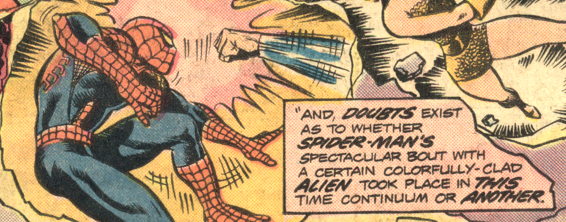
…though to be fair, he didn’t say he didn’t know, just that doubts exist as to what universe that meeting belonged. It’d be just like Uatu to not tell us. …Actually, it wouldn’t be, this dude blabbed a lot in this series.
Anyway, thanks to Twitter pal WormDrive PRO, we have these samples of letter column concern in regards to that first Superman/Spider-Man team-up from Amazing Spider-Man #158 and #159 (1976):
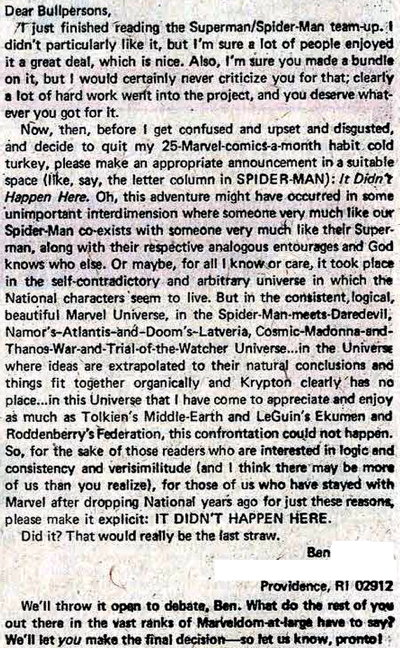
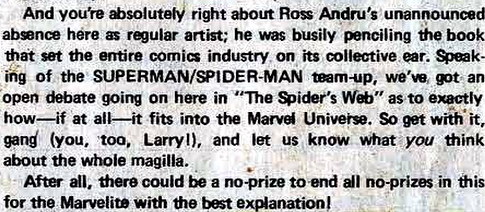
I don’t know what the ultimate resolution or response was to that editorial “what do YOU think?” but boy, that letter writer sure was mad about the guy logically bitten by a radioactive spider and thus given spider powers meeting an alien arbitrarily sent from an exploding planet. I suppose it’s a tribute to Marvel’s construction of a shared universe that some readers would get so upset about the intrusion of elements that would seem to disrupt it. I mean, it’s only just a comic book, they should really just relax…the very idea that maybe the two companies just wanted to have some fun and see what happened when they paired their heroes (and also make a ton of cash in the process) was a distant second to the threat that the Marvel Universe might be “diluted” by this most unnatural contact.
But the question was eventually answered. It’s Earth-7642. There you go, long ago letter writer, that’s the solution. See, wasn’t that easy?
So I was thinking about multiverses and parallel Earths, as one is wont to do, specifically in the context of comical books. Amongst this reflection one of the topics was “what was the first multiverse story I ever read in comics?” Given I was primarily a DC kid, and given that company was the one that traded most in this sort of thing, I’m sure it was some DC comic from the late ’70s/early ’80s.
Just to keep you from being in suspense, the answer is “I don’t know,” as DC’s set-up of “Earth-One” (where DC’s main line of heroes lived), “Earth-Two” (where the Golden Age characters lived, and for the most part were older than our regular heroes), “Earth-Three” (Oops, All Villains) and so on were pretty ingrained in me from the start. Maybe it was introduced to me in the digest reprints, maybe a Flash team-up with the Golden Age Flash. I even remember Bob Rozakis in one of his Answer Man columns running down the list of DC’s various Earths (which is where I learned that “Earth B is where all the stories that don’t make sense take place!” — a veiled reference to Robert Kanigher and/or Bob Haney, apparently. And no, that exact column isn’t at the link, but plenty of good examples of what Bob was up to there).
I know my favorite parallel Earth story is this one, a Justice League of Earth One/Justice Society Earth Two team-up — an annual tradition, as least for a while. That Gerry Conway/George Pérez extravaganza remains in my head the quintessential multiverse story, and is just plain Good Comics.
Anyway, parallel universes were just part of the fabric of DC’s superhero comics, and while it could lead to some confusion for the uninitiated, such as when apparently DC got some real world attention when Superman married Lois Lane in Action #484…the Earth Two Superman that is! Some folks were like “um, so not the real Superman?” Anyway, it was sort of deliberately misleading even to the initiated, as you may be able to tell from this cover:
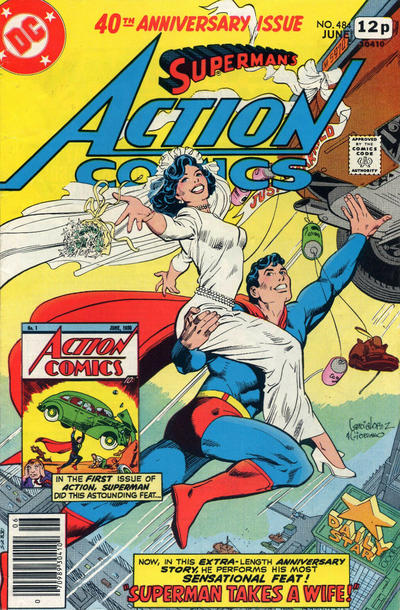
…where Superman’s chest emblem is deliberately obscured. As all true Earth Two fans know, the Superman of that Earth had a slightly different design. You can see the difference in this pic from Crisis on Infinite Earths, with Two on the left and One on the right:
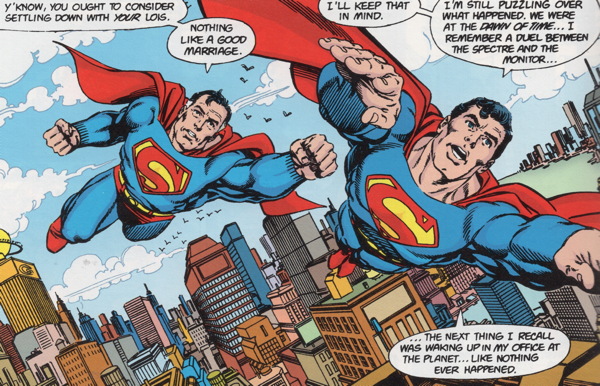
And I’m pretty sure the fact that it was Earth Two Superman tying the knot was not made explicit, as per this news blurb from The Comic Reader #150 (February 1978):
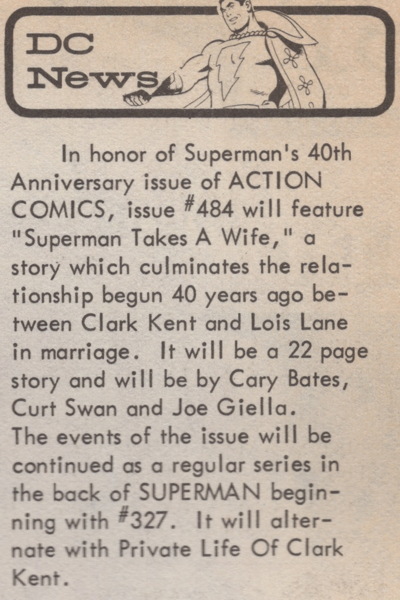
I mean, sure, you can maybe infer it after the fact, with all the “40 year relationship” talk, as, well, the Superman of Earth One clearly hasn’t been wooing Lois for 40 years, they must be talking about that Superman on Earth Two who’s been around since Dubbya Dubbya Too. But honestly, even without all this, most people picking up the book were probably “yeah, right, sure, Superman’s getting married, I’ll believe that when I see it” and then, well, they saw it. Surprise! Just not the Superman they may have been expecting.
That was bit of an aside, I realize. Been meaning to bring that up somewhere for years. So please excuse the lack of transition to the next bit.
When Crisis on Infinite Earths hit a few years later, well…okay. I think I’ve said it here before, I’ve definitely gone on about it on Twitter, but a major element of COIE was experiencing the Big, Permanent Never-to-Be-Reversed Changes in real time. Opening up issue #1 and having it lead off with the destruction of Earth Three and the character thereon was quite the shock. The art’s impeccable, the story is, um, well…the art’s impeccable, and it was an exciting read at the time as you didn’t know what drastic thing was going to happen next to the DCU. And worlds lived, worlds died, and nothing remained the same…
…and then DC spent decades trying to make everything the same as it was, or at least a close approximation, as event after event was released trying to patch Crisis with more Crises, more events, more restorations of parallel Earths and multiverses, even until right this very moment. And none of it feels as simple and as, honestly, organic as when we had our annual JLA/JSA crossovers, or when the Golden Age Green Lantern would team up with our Earth One Green Lantern, and so on. Sure, there was the occasional roadbump, like that Action #484, but eh, we dealt with it.
I’m trying and likely failing to not sound like Cranky Old Fan Wants Things Like They Were, because…look, I like new comics just fine. I’m even enjoying Dark Crisis (now Dark Crisis on Infinite Earths, as of issue #4). And I’ve liked a lot of the weird multiverse stuff we’ve been getting recently. But I keep thinking “maybe if COIE didn’t happen, a whole lot of creative energy could’ve been used for something other than trying to fix it.” Hypocritically, I’ve read every one of these attempts and mostly enjoyed them for their strange metatextual efforts. Yes, even Doomsday Clock.
But I think DC has given up their once-strong multiverse advantage to Marvel, who’s grabbed the concept with both hands and wrestled it to the ground, making the idea their own. Should the Flashpoint movie ever actually come out, it’s gonna look like an also-ran with its multiversal storytelling after Marvel’s been riding that wave through multiple movies and TV shows. And yes, the Flash TV show covered that ground as well, but I still think it’s really Marvel’s ball now.
More on Marvel next time. Thanks for enduring this post, pals…had a lot of semi-related thoughts to get out of my head, and it turned out I have a blog so here they went. See you Wednesday.
So back in Ye Olden Dayes of this blog, when I wrote about specific comics, all I had to do was dip into the Vast Mikester Comic Archives and pull out a copy of the book I wanted to discuss. “Ah, yes, fetch me that copy of Superman’s Girlfriend Lois Lane #106, would you Jeeves, that’s a good chap,” as I reclined into my Marc Newson Lockheed Lounge Chair, quill in hand, ready to pen the latest enthralling installment of Progressive Fancypants dot com.
Well, that changed when all thoughts of fancypantsness went out the window as I opened up my own comic book store, and the Vast Mikester Comic Archives became The Dismal Dregs once I gave over my personal stock to shop stock. Now when I want to discuss a particular book, it’s either one that I came across at my store, one I can pull images from DCUniverseInfinite.com, or I can bum pics off a pal, usually Bully.
It’s particularly frustrating when the books I want to discuss are definitely ones I bought off the stands at the time of release, and long since given up to the shop, such as 1985’s Heroes for Hope Starring the X-Men from Marvel Comics:
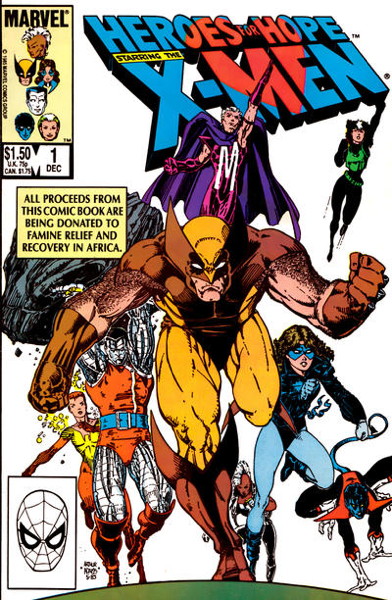
and Heroes Against Hunger from DC Comics:
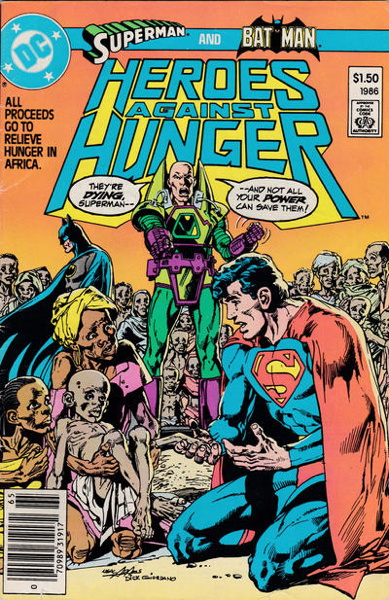
Produced during that time pop culture remembered that Africa was having some problems, these were fundraising comics to aid the fight against starvation. Honestly, I don’t know how much money was raised by these projects, given each had a price tag of $1.50, so the wholesale price was about half that (unless there was a different discount structure in place for these particular books, which is possible), and unless those distributors also donated their share of the profits…well, that wasn’t much per issue going to charity. It’s a little better once you multiply that portion of the cover price by however many copies were sold to retailers (for which I have no info, so I’m gonna make the rough estimate of about 300,000 for the X-Men book, and half that for the DC one), then maybe you’re talking some real money. Maybe not “We Are the World” money, but not nuthin’, either.
I’m sure some enterprising person out there already crunched all those numbers and I’ll hear about it shortly, but that would take some kind of “internet search engine” to locate something like that. I’ll have to ask my man Jeeves to look into it. Anyway, that’s not what I’m here to talk about.
No, what I’m here to talk about is the impact these books had on me, and possibly also on cultural awareness overall (as far as “comic book fandom cultural awareness” goes on something like this). And all this came about because I was processing a collection the other day that had a copy of the Marvel benefit book. That in itself isn’t terribly unusual…copies of this title show up in collections all the time, far more frequently than the DC counterpart, which is why I presumed earlier the vast disparity in printruns.
But whenever I get a copy, I poke through it and marvel (so to speak) at the creative teams they put together for the short vignettes within…usually only two or three pages long by a specific creative team. There is a bare thread of a storyline connecting everything, but the real meat are the small character bits each short provides, as the various X-Men face personal, emotional challenges. Harlan Ellison and Frank Miller presents Wolverine rising above his savage instincts, Chris Claremont and Brian Bolland have Storm confronting her various self-images, Stephen King(!) and Bernie Wrightson have Kitty face off against…well, hunger (there’s more to it than that, didn’t flip through it agin to refresh my memory, but boy that “Good God, let’s eat!” still sticks with me). And then there’s this, which I took an askew shot of at the shop to post onto Twitter:
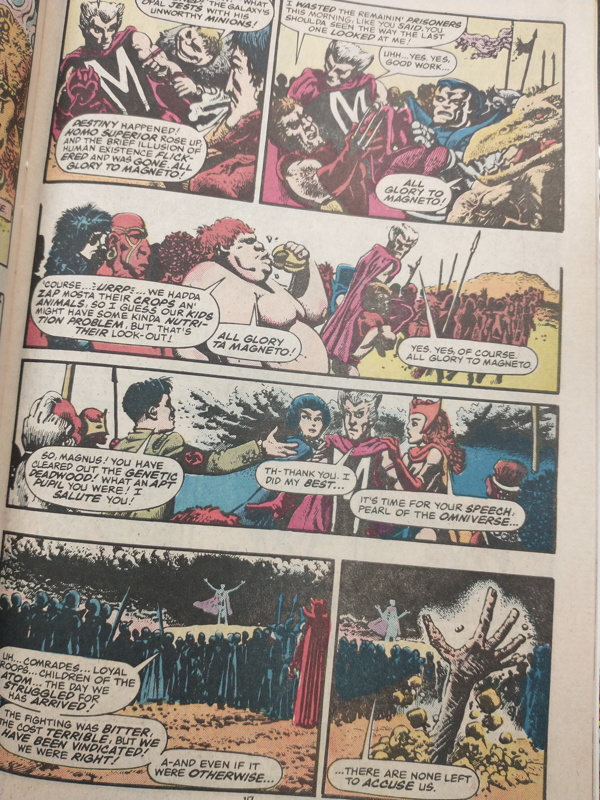
…contrasting Magneto’s Holocaust survivor background with the future he may bring about with his battle for mutant superiority over the common folk. I mean, Hitler shows up on this page to praise Magneto, it ain’t exactly subtle. It’s Alan Moore in a very rare bit of Marvel work (his only new post-UK work for the company, I believe), drawn by the underground comix legend Richard Corben. Not shown (except a bit in the last panel of that page there) are the great rotting corpses that only Corben could create. It may very well be one of my favorite bits of X-Men comics.
Here’s the thing about not having these comics readily accessible in my collection any more. I have to depend on my memories of having read the books. Yes, I said I get the Marvel book in collections all the time, but I’m not spending time to flip through each copy that shows up. It was only the other day where I thought “you know what’s good? this Moore/Corben sequence” and decided to take a picture of it so I could say so on the Twitterers. Many of the images and events of this comic stick in my mind clearly, nearly 40 years after I first saw them. That emaciated Kitty Pryde, Wolverine standing triumphant, Storm in her various guises, a guilt-ridden Magneto. I don’t remember a whole lot else from the comic, but those have been living in my brain a very long time.
Now let’s take the DC book. Similar in structure to the Marvel comic, it’s made up of short 2-3 page sequences each by a different creative team, strung together into a semblance of a story. I have two primary memories of this comic, which I definitely bought and read at the time.
The first memory is of a review I read of it in, well, probably has to be Amazing Heroes. Basically the complained about the inconsistency of the writing, specifically citing that Lex Luthor’s characterization would change from segment to segment. An inherent problem, I suppose, in having this many writing cooks in the kitchen.
The other memory was of Luthor weeping when put face to face with starving people. I mentioned that scene online, and it was Twitter pal BobH to the rescue, snapping a pic of that very moment:
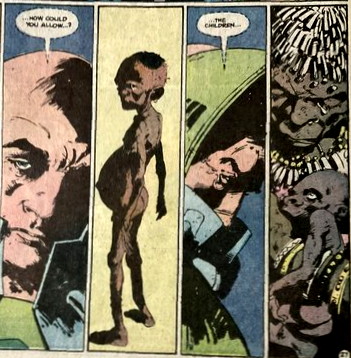
As BobH pointed out, that’s by Barry Windsor-Smith and Catherine Jones, an impressive art team by any measure. He also mentions Bernie Wrightson inked by Mike Kaluta (wow!) and Jose Luis Garcia-Lopez inked by Jerry Ordway (another shot from BobH):
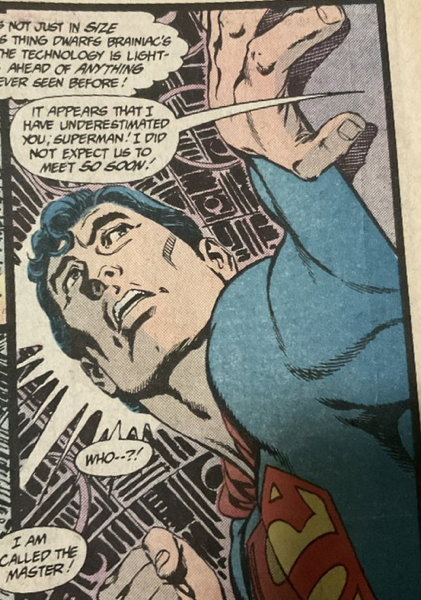
A look at the credits shows lots of other impressive (and weird) combos. I mean, Carmine Infantino and Murphy Anderson! Curt Swan inked by John Byrne! Walt Simonson inked by Steve Leialoha! (That one’s gotta be weird!) C’mon, Kirby is in this! There’s a lot of what should be some spectacular work in here.
I just don’t remember any of it. Nothing from the book stuck, except that one image of Luthor. (Which I liked, by the way…I always preferred the “yes he’s a bad guy but not a complete monster” pre-Crisis Luthor to the nigh-irredeemable post-Crisis Luthor we’d get only a couple of years after this.) Otherwise my mental image of the book was that it was…cluttered and cramped, overly talky and not as visually memorable or striking as the X-Men comic. The DC one even had its own Big Name Horror Writer in Robert Bloch, for a sequence also drawn by Wrightson, and hand-to-God I couldn’t tell you a single thing about it.
Not to say the X-Men book totally ruled and the DC one drooled or anything. The former had a bit by Mike Baron/Steve Rude, a creative team I normally like, which I looked at briefly in the copy I had at the store and gosh darn if I could tell what was going on. And frankly the DC book sounds a lot better than I remember, but I still feel like it does just sound that way, that something in the execution made it a less memorable offering that the Marvel release.
Lot of words to throw at you to essentially say “I remember one book more fondly than the other” but this is just one of those things I go through as an older fan who’s had a lot of comics pass through my hands. Interesting in that both Jim Starlin and Wrightson were involved in creating the storylines for both.
Anyway, I put this here so that I can maybe get some feedback on the books, about what I’m not remembering, about what was outstanding about the DC book that should be remembered as well as those top-flight stories from the Marvel comic. But I have to be honest, it’s gonna be hard to beat that Magneto strip.
EDIT: Everything old is new again! I just reminded myself that I wrote about these books on the site before, because of course I have! Here I am talking about the Marvel one, and here’s DC…more images (and some linkrot) for your perusal!
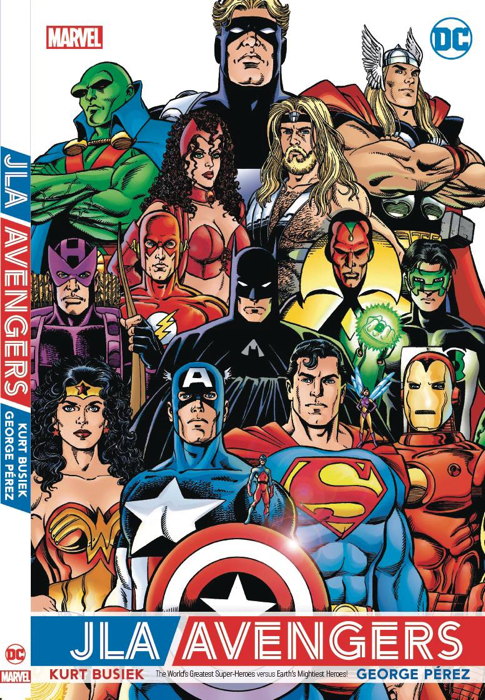
So as I’m sure you’re aware, JLA/Avengers is finally getting a new printing via the comics industry charity Hero Initiative, with all profits going to it. That is, all profits from direct distribution to retailers, but more on that in a second.
What’s putting folks out about this particular minor miracle, which saw Marvel and DC work together for the first time in years in order to allow this republication to happen, is that so few copies, relatively speaking, are going to be available. There’s a printing cap of 7,000 copies, for reasons I’ve seen here and there on the internet ranging from “that’s all we can get printed with the time and resources available” to “lawyers, man, whatcha gonna do?” No idea what the actual answer is, beyond the fact that Hero Initiative probably didn’t sign on to keep the book in print forever, so a max print run had to be set somewhere.
And as you also know, the legendary Mr. Pérez recently announced that he’s stricken with a terminal condition, with only months to live, hence the rush to get this book out while he can still see it. It’s nice that Marvel and DC were able to come to terms to allow a charity reprinting of this series, for which I presume “neither of us are getting the money from this so we’ve got nothing to fight about” helped things along.
But like I said, only 7,000 copies are going to make it out to the world with this printing, minus however many copies get damaged during distribution to retailers. One would hope that DC and Marvel are currently looking at the frenzy this limited availability is causing and are reconsidering any future publishing plans regarding this title. I know there’s some hoohar over profit-sharing on this book, to the point where not publishing it at all and making no money on it is somehow preferable to getting it out there and making at least a little money on it. I’ve said in the past that my solution is just let each publisher release their own trade paperback of JLA/Avengers (or Avengers/JLA for the Marvel book) and keep all profits from their own publication. But I’m sure there are legal/financial reasons from even that being able to happen.
Anyway, all I know is that I’ve been deluged with requests for this book, and I’ve started a first-come/first-served waiting list. For once, the people who actually want the book to read and enjoy were in reasonably early, while the Usual Suspects with the eBay auction listings all ready to go are a day late and a Bitcoin short. But make no mistake, this book is going to be flogged at some sky-high prices the second it’s out. Way to honor George Pérez, guys.
But because there is a limited quantity, and order allocations are almost certain to occur, it is very possible the only person on the list I’ll be able to provide for is the first one who got his name on the list. It is actually very possible, depending on how other stores place their orders, that I get zero copies. If enough bastards out there type “7000” into the order slot on the distributor website to get max allocations, maybe there won’t be enough left over for anyone else.
I’m guessing I’ll get at least the one copy, though. I am ordering a larger number of total copies under the assumption it’s going to be reduced. I was guessing that I’d likely only get about 10% of what I ordered and placed numbers accordingly, but I’m beginning to think 10% is highly optimistic. I also don’t want to order too high, then hear “oh, we’ve upped the print run, everyone’s getting every copy they ordered!” and then I’m stuck with all 7,000 copies. Er, I mean, someone is stuck with that many, I certainly didn’t order 7,000.
Ultimately I hope Marvel and DC do see that people want a nice collected edition of this beautifully-illustrated goofy mess of a comic. The amount of love Pérez put into this comic shouldn’t be forgotten by history or kept out of the hands of fans new to the hobby. I mean, right now the Justice League and the Avengers are at what may very well be their height of cultural awareness (admittedly for drastically different, and not always good, reasons). Strike while that iron (man) is hot.
I am glad it’s back, even for as small a print run as it is, but I’m hoping this leads the way to more copies of it from Marvel and/or DC.
P.S. I always wonder how much negotiation when into things like that cover above. “Superman has to be taller than Captain America.” “Okay, fine, but Cap is standing in front.” “We’ll give you that, but the Atom has to be standing on his shield.”
P.P.S. When reading a few online articles about this, came across one site giving a brief history of Marvel/DC team-ups and saying
“…Doomsday Clock noted a future Marvel and DC crossover called Secret Crisis, but it’s not certain if this is actually in the works.”
NO, IT’S NOT IN THE WORKS, it’s just something Geoff Johns threw in there while making his point about Big Crossover Events. Not saying it can’t happen, especially after Disney buys Warner Bros., but I’m pretty sure it wasn’t intended as an Actual Thing in the Works.
P.P.P.S. Variant cover-age Monday posts are returning, they’re just resting for a moment.
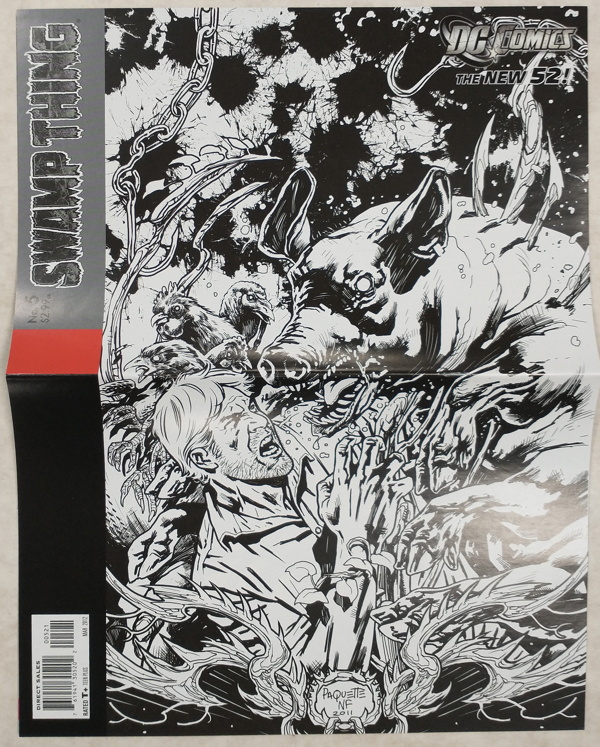
So it dawned on me that I might be opening up bit of a can of worms here, as DC’s New 52 publishing initiative was rife with variant covers. Initially, I was just going to talk about these black and white variants DC offered early on in the initial months of New 52. Like, for example that Swamp Thing one above, which I removed from the formerly vast Mikester Comic Archives to photograph. (Er, pardon the glare.)
As I recalled, several DC titles around this time had this particular style of variant, taking the regular cover, flipping it on its side and stripping it of its coloring. This Swamp Thing issue (#5, March 2012) was offered in a 1:25 ratio, meaning a retailer would have to buy 25 copies of the main cover to order one of these. …Look, I know most of you know how ratio variants work, but someone reading this might not.
In looking at other DC titles, it appears Batman #5 also had a similar variant, but it was a 1:200 ratio book…which makes sense, since Batman is nearly always a top seller for DC. Aquaman #5’s variant, another 1:25. Same with Superman #5. Even Detective Comics #5 was only 1 in 25.
I’m not going to look up every 5th issue of the initial New 52 series to check the ordering plateaus for these black and white wraparounds (and not all of them had ’em…sorry, Blackhawks #5), but I’m going to hazard a guess and say the main Batman title was the one series with the highest “ask” to get that variant. If I’m wrong, I’m sure I’ll hear about it.
These black and white variants are kinda neat. It’s like you’re getting your own reproduction of the original art, in varying stages of development: fully inked, like on the Swamp Thing cover, or just the pencils, like on that Aquaman cover. Which is nothing particularly new or innovative, as black and white “sketch” covers had been a thing already, but by turning it on its side, wrapping the image around the front and back covers, now it more closely approximates the size of what we generally think of original art pages. (Yes, not exactly, hence my use of the word “approximates.”)
I don’t have specific retail stories about these black and white variants, beyond me unsurprisingly glomming onto the Swamp Thing one as soon as I cracked open the Diamond delivery boxes. But what I do want to talk about is DC’s increasing reliance on variant covers over the history of the New 52’s lifespan, as alternate and gimmick covers were prodcuced to shore up the orders after the initial excitement over the relaunch started to fade away.
Variant covers were there from the very beginning of the New 52, with some titles (like Batman and Superman offering other covers based on your lowest DC order for the week. For example, if your lowest order for a DC title coinciding with Batman‘s release was only 20 copies, then you were limited to 20 copies of that one Batman variant. Thus from the get-go, they weren’t even waiting for numbers to drop. They were trying to get you to order more of a comic in which you didn’t have as much faith so you could get yer mitts on more of that Batman variant. Very sneaky.
And there were more variants than that from launch, especially for Batman, not even counting the variations on the several reprintings for this and other New 52 titles (which, as I said last time, is a little outside the range of this overview). I intend to cover more the DC New 52 variants, making this a bit of a series inside the variant cover-age series already in progress, as it’s clear I’m never going to squeeze all these into one post. I mean, I suppose I could, but I don’t really want to be up ’til 4 AM writing a blog post, like I used to do when I was a young and spritely 34 years of age when I started this site nearly two decades ago.
So hang onto your butts, as this variant ride is going to be taking on the New 52 variants over the next few weeks. I of course reserve the right to interrupt the run with breaking variant news, but we’ll see how it goes.
So to add to my Superman: Birthright discussion on Monday, the writer of said book, Mark Waid himself, dropped on by to clarify/correct some of my assumptions. Primarily, that Birthright was indeed intended to be the new “official” Superman origin, but was eventually decided that yet another version, the Geoff Johns/Gary Frank Secret Origin mini, would be the new official origin instead. Least ’til, you know, they changed it again.
Anyway, here’s a period article with an interview with Mr. Waid about Birthright being the “official” origin, which was declared so late in the run due to the Super-books being “still somewhat in flux” when the series began. While I was correct in that the state of Superman’s history at that point was a bit mushy and open to revision, as I said in my last post, my assumption that Birthright was a planned out-of-continuity story that eventually ended up in continuity despite itself was incorrect.
So, when you reread that last post of mine, disregard my poor use of Birthright as an example for my thesis. I think my overall entry there is correct, in that if you leave any ambiguity to the canonicity of a story involving DC or Marvel characters in what appears to be their familiar milieus, the default position of a certain subset of fandom regarding that story is that it’s part of official continuity. And that the emphasis, especially by DC, on continually trying to establish what is their official continuity only encourages the behavior.
Not all fans do this, of course, but like I said, I’m still getting customers asking me if Three Jokers is, you know, Real Joker History and, well, what can you do. “It is if you want it to be!” I’ve answered more than once, and I don’t know if that helps, really.
Okay, let me say something about a couple of comics that came out this week:
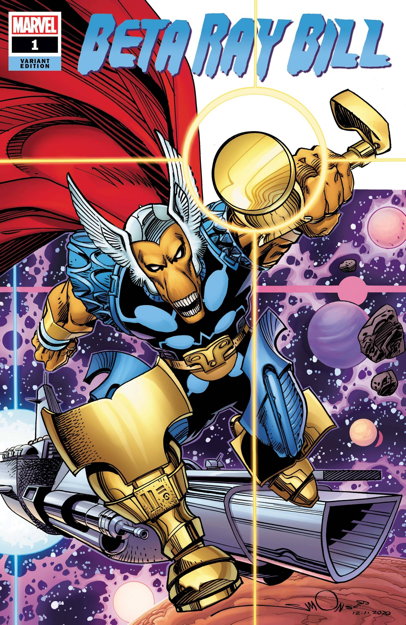
I didn’t keep the cover pictured above…this is one of those “retailer incentive variants” that I have to order a certain number of the regular covers in order to receive. But you think I’m gonna pass up posting a kickass Beta Ray Bill pic by his creator, Walt Simonson, on my site? Heck no.
Anyway, the entirety of my Thor reading is as follows: the Walt Simonson run from #337 to #382 (plus the couple of fill-in issues in that run, which were also great), whatever stories were in the Origins of Marvel Comics books, and the Lee/Kirby “Search for Galactus” issues that pal Cully let me borrow once. Nothing against Thor, and I know some later runs of Thor are very highly regarded, but my brain decided “That’s All The Thor I Need” and that was that, I guess.
When I opened my own shop a few years ago, I gave up my Thors (not Cully’s Thors, I returned ’em, honest) to the back issue bins, which was a good idea because boy did they sell well. As they should, because they’re beautiful and perfect, but “Fanboy Mike” is a tad annoyed at “Retailer Mike” as I kind of miss having those. But hey, I figured at the time I could always pick ’em up in reprints one way or another.
So basically I haven’t been involved in Thor comics for a while. Then why pick up Beta Ray Bill #1? Well, the work of Daniel Warren Johnson for one, who is writing and drawing this book and it looks fantastic. I’m not one for two-page spreads in comics nowaways, but Mr. Johnson throws in a couple of them in this issue and I know I really like a comic when that doesn’t bug me in the slightest. It all feels like a natural extension of Simonson’s rendition of the character without being an imitation of his style, in a way that previous efforts with the Beta Ray Bill have not.
As someone who, as I just told you, hasn’t been immersed in recent Thor comic shenanigans, there wasn’t a steep learning curve for getting caught up to speed on recent Asgardian events. Johnson does a good job naturally slipping in the necessary exposition to establish the world of the book and the premise for the series.
Yes, it is, nominally, a tie-in to the “King in Black” event currently happened at Marvel, but it barely counts, a “Red Skies” type of crossover where a Surprise Guest Monster shows up to wreak havoc in Asgard and oh, he’s all King in BLack-ized or whatever they call it. Could easily just have been Special Surprise Guest Monster all on his lonesome and the effect on the plot wouldn’t have been any different, really. But if it gets more eyeballs on the comic, then we shall let this pious fraud pass.
What I’m saying is that Beta Ray Bill is just as good as I’d hoped it would be, since seeing preview pages a while back. As someone actively not looking to pick up new series right now due to my immense funnybook backlog caused by eyeball issues, I snatched this one up with no regrets.
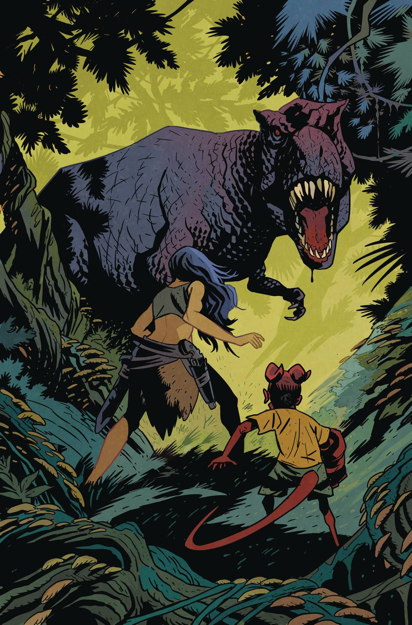
Young Hellboy is a fun, cute series, the second issue of which is out this week. Young Hellboy runs into a Golden Age-style jungle girl on a mysterious island, and seeing HB as an overly talkative, hyperactive child is always entertaining. With the forward motion on the “current” Hellboy timeline effectively ended with, um, the end of the world, it’s nice that we’re still getting “flashback” Hellboy stories. “Hellboy may be dead but his cash flow lives on,” as the Dead Milkmen said (slightly paraphrased). Even knowing the eventual end point for the Hellboy Universe, the sense of impending doom doesn’t weigh too heavily upon these stories…I mean, not that particular doom, anyway.
It’s a nice reminder of what Hellboy was, back before the plot overtook the premise and everything was pointing to The End, versus just the big red guy smacking monsters around and shooting (badly) at demonic foes. Or, as in this series, swinging on a vine and shouting with glee. As I said, fun and cute.
Unlike my hope at the end of the last post addressing Daniel’s comment about DC and the rebooting and the continuities, I do in fact have yet another early morning appointment waiting for me as I write this the night before it. I believe that’s the last of said appointments for a while, the timing of which is unfortunately a necessity when one has a seven-day-a-week job. So let me be quick like the bunny in these responses:
“For me, the DC characters are strongest when they’re in a perpetual state of reboot and/or Elseworlds variations. Seeing a young Batman meet the Joker for the first time in stylistically and narratively different ways each time is infinitely more interesting to me than seeing 80-year-continuity Batman meet the Joker for the 368th time in their ongoing history.”
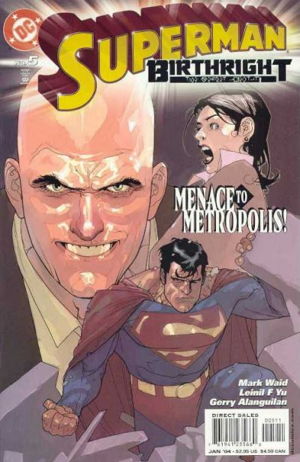 Nearly, urgh, 20 years ago, the mini-series Superman: Birthright by Mark Waid, Leinil Yu and Gerry Alanguilan was released, retelling the early years of Superman’s life. It wasn’t intended to be part of regular continuity; rather, just a fresh interpretation of Superman’s origin by a talented creative team, unburdened by the need to be tied to anything else DC was doing with the character.
Nearly, urgh, 20 years ago, the mini-series Superman: Birthright by Mark Waid, Leinil Yu and Gerry Alanguilan was released, retelling the early years of Superman’s life. It wasn’t intended to be part of regular continuity; rather, just a fresh interpretation of Superman’s origin by a talented creative team, unburdened by the need to be tied to anything else DC was doing with the character.
I suppose what happened was that the story told in Birthright wasn’t distinct enough from mainline continuity…not branded “Elseworlds” or whatever. Not the fault of the creative team, of course, but the Superman story post-Crisis and post-Zero Hour had perhaps become nebulous enough, and distant enough from the mid-1980s John Byrne reboot, that Birthright somehow came to be considered part of the “official” origin. I believe it was this story that reintroduced the Silver Age-y idea of Lex Luthor living in Smallville when he was young, effectively de-aging the Byrne version (who’d already been de-aged via clone/deal with Neron shenanigans that I’m not going into here) from being decades older than Clark Kent to maybe only being a few years, at most.
EDIT: Please check the comments for some clarification from Mr. Waid his own self.
Daniel, I think ideally, for the purposes of DC’s maintenance of a superhero universe, having the “in-continuity” stories is fine. And your idea of having varied tellings and retellings of stories featuring the characters that don’t have to be shoehorned into that continuity is great. Does Batman: Three Jokers fit into the official, current Batman history? Will it ever be referenced outside of a Three Jokers sequel? Probably not. I know I spent a couple of posts picking at the continuity details of this story, but, really, ultimately, it doesn’t matter. It’s a standalone story you can enjoy (or not enjoy, as the case may be) as in-continuity, if you’d like, or outside of it.
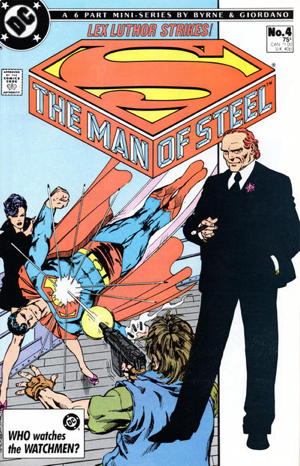 Part of the problem is that DC’s constant obsession with “fixing the universe” in most of their Big Events reemphasizes the idea that Continuity Matters, that all the pieces need to fit and be consistent. So when stuff like Birthright and Three Jokers come along, which (at least in the former, can’t say for sure about the latter) aren’t intended to be part of regular continuity but aren’t immediately identifiable as being separate from it, the readers can get it into their heads that they’re supposed to consider these stories are part of the Official Big Picture. I mean, if Batman’s not, like, a pirate in the story, or Superman’s rocket didn’t land in Norway, which is what DC has essentially trained its readership to look for when considering if a story is, biggest quotation marks ever, “real” or not.
Part of the problem is that DC’s constant obsession with “fixing the universe” in most of their Big Events reemphasizes the idea that Continuity Matters, that all the pieces need to fit and be consistent. So when stuff like Birthright and Three Jokers come along, which (at least in the former, can’t say for sure about the latter) aren’t intended to be part of regular continuity but aren’t immediately identifiable as being separate from it, the readers can get it into their heads that they’re supposed to consider these stories are part of the Official Big Picture. I mean, if Batman’s not, like, a pirate in the story, or Superman’s rocket didn’t land in Norway, which is what DC has essentially trained its readership to look for when considering if a story is, biggest quotation marks ever, “real” or not.
Look, I know most people aren’t worried to this extent about their comic book stories. I read (and am still reading) the Superman comics from the Byrne reboot ’til today, and I can draw a more or less unbroken line from what happened then to what’s going on now. Is everything entirely consistent? No, of course not…it wasn’t even before the whole Flashpoint/New 52/Rebirth hoohar. Does that bother me? Nah, not really. I tend to go on about some of the inconsistencies here on this site, but more out of amusement than outrage. As a wise philosopher once almost said, “it’s just a [comic book], I should really just relax.”
In short, if I can ever be short, DC has its readership used to the idea that continuity is paramount, and therefore every story has to “count.” Thus, doing stories that aren’t necessarily in continuity can become difficult to distinguish as such unless they contain gimmicks that decidedly make them outside the main storylines. Thus, anyone really bothered by this sort of thing, which isn’t everybody, I know, but it ain’t zero people, can find things to be confusing.
“And I think that this is part of DC’s brand management problem. I believe that there are just as many people like me who love the excitement and variation of reboots as there are people who prefer (and want to perpetuate) the never-ending 80-year soap opera. And any attempt to go in one direction or the other will inevitably alienate the other audience.”
I know DC has been messing with branding logos on their comics to identify which “family” their books are in, with a general “DC Universe” for those without specific categories. Maybe a general icon that means “YES, THIS IS IN WHATEVER OUR CONTINUITY IS NOW.” Which is its own problem, because then maybe people wouldn’t buy the one-offs and minis without the logo because they’re outside continuity? You see the difficulty. I think just ending the Big Event reboots, and changing things as necessary in the comics as time goes on, without making a big deal out of it, is the best solution. If DC stops making such a big deal out of continuity, maybe readers will too. Well, some readers, anyway. I’ve been at this too long, I know better.
I don’t know. I think folks should just read the stories they like and if they want to think some story is or is not part of the larger picture, then go to town, friend. In my personal head canon, those stories where Alec Holland’s brother “cures” Alec, followed by Swamp Thing teaming up with the Challengers of the Unknown and Deadman are all still part of the character’s history, and nobody’s gonna tell me different.
« Older Entries
Newer Entries »



















 Nearly, urgh, 20 years ago, the mini-series Superman: Birthright by Mark Waid, Leinil Yu and Gerry Alanguilan was released, retelling the early years of Superman’s life. It wasn’t intended to be part of regular continuity; rather, just a fresh interpretation of Superman’s origin by a talented creative team, unburdened by the need to be tied to anything else DC was doing with the character.
Nearly, urgh, 20 years ago, the mini-series Superman: Birthright by Mark Waid, Leinil Yu and Gerry Alanguilan was released, retelling the early years of Superman’s life. It wasn’t intended to be part of regular continuity; rather, just a fresh interpretation of Superman’s origin by a talented creative team, unburdened by the need to be tied to anything else DC was doing with the character.  Part of the problem is that DC’s constant obsession with “fixing the universe” in most of their Big Events reemphasizes the idea that Continuity Matters, that all the pieces need to fit and be consistent. So when stuff like Birthright and Three Jokers come along, which (at least in the former, can’t say for sure about the latter) aren’t intended to be part of regular continuity but aren’t immediately identifiable as being separate from it, the readers can get it into their heads that they’re supposed to consider these stories are part of the Official Big Picture. I mean, if Batman’s not, like, a pirate in the story, or Superman’s rocket didn’t land in Norway, which is what DC has essentially trained its readership to look for when considering if a story is, biggest quotation marks ever, “real” or not.
Part of the problem is that DC’s constant obsession with “fixing the universe” in most of their Big Events reemphasizes the idea that Continuity Matters, that all the pieces need to fit and be consistent. So when stuff like Birthright and Three Jokers come along, which (at least in the former, can’t say for sure about the latter) aren’t intended to be part of regular continuity but aren’t immediately identifiable as being separate from it, the readers can get it into their heads that they’re supposed to consider these stories are part of the Official Big Picture. I mean, if Batman’s not, like, a pirate in the story, or Superman’s rocket didn’t land in Norway, which is what DC has essentially trained its readership to look for when considering if a story is, biggest quotation marks ever, “real” or not. 





